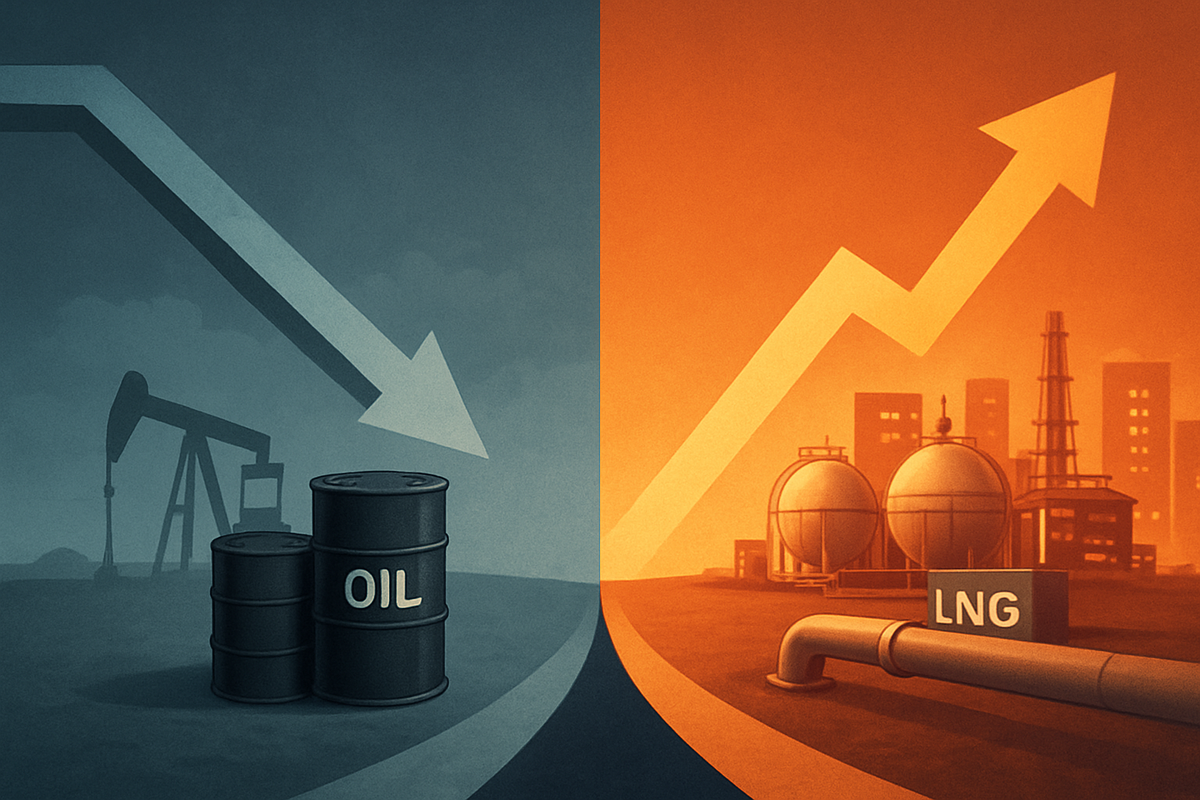
The global energy market is currently experiencing a significant divergence, as of November 7, 2025. Crude oil prices are facing sustained downward pressure, driven by a looming oversupply and moderating demand, setting the stage for potential price corrections. Conversely, natural gas prices have seen a sharp rebound and are trending upward, fueled by strong global demand, particularly for Liquefied Natural Gas (LNG) exports, and expectations of a colder winter. This creates a complex and volatile environment with immediate implications for global economies, energy producers, and consumers alike.
The immediate implications are stark: lower oil prices offer a reprieve for consumers and energy-intensive industries by reducing fuel costs, but they simultaneously challenge oil producers, potentially leading to reduced capital expenditures and drilling activity. In contrast, surging natural gas prices benefit producers and LNG exporters, bolstering their revenues, but present increased cost burdens for industries reliant on gas as a feedstock or energy source, such as the chemical sector. This dual dynamic highlights the intricate balance of supply, demand, and geopolitical factors shaping the world's energy future.
Detailed Coverage: Unpacking the Dynamics of Oil and Natural Gas
The past year has been a rollercoaster for energy commodities, with distinct trends emerging for crude oil and natural gas. Oil prices, after reaching highs in early 2025 due to geopolitical tensions and strategic production cuts, have since moderated and are now on a clear downward trajectory. Brent crude is trading around $63.62 USD per barrel, and West Texas Intermediate (WTI) at approximately $59.75 USD per barrel, both showing weekly losses. This decline is largely attributed to a prevailing anticipation of a significant oversupply in late 2025 and extending into 2026, driven by robust production growth from non-OPEC+ nations like the United States (which hit a record 13.65 million barrels per day), Brazil, Canada, Guyana, and Argentina. OPEC+ has gradually unwound some cuts, and Saudi Arabia has even slashed December crude prices for Asian buyers to an 11-month low, signaling weakening demand. Global oil demand growth remains subdued, particularly in advanced economies, due to a harsher macroeconomic climate and the accelerating adoption of electric vehicles.
The timeline leading up to this moment reveals a calculated unwinding of production strategies. Throughout 2024, OPEC+ maintained voluntary production cuts of 2.2 million barrels per day (b/d), extended through March 2025. In December 2024, the alliance decided to extend overall quotas until December 2026, with a plan to gradually phase out the 2.2 million b/d adjustments by September 2026. By April 2025, a formal decision was made to begin this gradual unwinding, and by July 2025, eight key OPEC+ countries agreed to a production adjustment of 548,000 b/d for August, representing four monthly increments. Geopolitical factors, including ongoing conflicts in the Middle East and the Russia-Ukraine war, have caused short-term price spikes but have not fundamentally altered the long-term oversupply narrative. Key players include the OPEC+ alliance (with Saudi Arabia as a pivotal member), major non-OPEC+ producers like the United States, and international energy agencies such as the EIA and IEA. Initial market reactions have been largely bearish for oil, with top global commodity traders warning of an imminent oversupply by October 2025, reinforcing the downward pressure on Brent crude.
In stark contrast, natural gas prices have seen a significant upward trend. The Henry Hub natural gas spot price is around $4.32 USD/MMBtu, despite a slight daily dip, having surged by 29.61% over the past month and a substantial 61.85% year-on-year. This rebound from historically low levels in 2024 is driven by strong and growing global demand, expected to hit a record high in 2025, primarily for power generation, industrial processes, and residential heating. Record Liquefied Natural Gas (LNG) export demand, especially from Europe and Asia, is a major contributor, with the U.S. poised to become the largest LNG exporter globally. Supply remains structurally tight despite rising U.S. production, and storage levels, while improving, are below average in some regions. Colder-than-average temperatures at the start of 2025 significantly increased demand, though recent mild weather forecasts have caused slight retreats. Geopolitical uncertainty continues to fuel volatility, particularly impacting Europe's gas balance. Initial market reactions suggest elevated natural gas prices are expected into late 2025 and early 2026, with the global LNG market remaining tight and vulnerable to disruptions.
Company Fortunes: Winners and Losers in a Shifting Energy Landscape
The diverging paths of oil and natural gas prices are creating a clear divide between public companies poised for gains and those facing significant headwinds. Companies heavily reliant on crude oil as a cost input stand to benefit from lower prices, while pure-play oil exploration and production (E&P) firms will likely struggle. Conversely, natural gas producers, LNG exporters, and midstream companies are set to thrive in the current environment, while energy-intensive industries using natural gas as a feedstock will face increased costs.
Airlines are among the primary beneficiaries of falling crude oil prices, as jet fuel constitutes a major operational expense. The International Air Transport Association (IATA) projects a significant improvement in global aviation industry net profits to $36.6 billion in 2025, largely due to cheaper oil, with jet fuel prices forecast to average $87 per barrel. This translates into substantial savings for carriers like Delta Air Lines (NYSE: DAL), potentially reducing annual fuel bills by $1.2 billion, freeing up capital for investment or shareholder returns. Similarly, paint manufacturers, such as Asian Paints (NSE: ASIANPAINT), could see improved margins as crude oil is a key raw material in their production.
On the natural gas side, producers and LNG exporters are poised for strong performance. EQT Corporation (NYSE: EQT), one of the largest and lowest-cost natural gas producers in the U.S. Appalachian Basin, is strategically located to supply the growing demand from AI data centers. Cheniere Energy (NYSE: LNG), the leading U.S. LNG exporter, stands to benefit immensely from surging global demand, with its long-term, fixed-rate contracts providing predictable cash flow. Midstream infrastructure companies like Kinder Morgan (NYSE: KMI), which operates North America's largest natural gas transmission network, are also well-positioned due to increased natural gas and Natural Gas Liquids (NGLs) volumes. Targa Resources (NYSE: TRGP) reported record Q3 2025 results, reflecting higher natural gas prices and NGL volumes, driven by active expansion in the Permian Basin.
Conversely, pure-play oil E&P companies face considerable pressure. Many U.S. oil producers have break-even prices averaging $61-$66 per barrel, meaning forecasted WTI prices around $47 per barrel in 2026 would be unprofitable. This could lead to reduced drilling activity, job losses, and significant pressure on revenues and margins for companies like ConocoPhillips (NYSE: COP), which reported decreased earnings in Q3 2025 due to lower realized prices. Even with hedging, the sustained decline will impact profitability. Chemical companies, such as LyondellBasell Industries (NYSE: LYB) and Westlake Corp. (NYSE: WLK), are grappling with rising natural gas and ethane prices, which are crucial feedstocks and energy sources. These elevated costs directly impact their production expenses and compress margins, particularly affecting North American polyethylene operations.
Broader Implications: The Wider Significance of Energy Market Volatility
The current energy market shifts are not isolated incidents but rather integral components of broader industry trends, signaling a significant rebalancing in global energy dynamics. The growing role of natural gas as a "transition fuel" is undeniable, with its demand sustained by its use in power generation and as a cleaner alternative to coal, particularly in Asia. The expansion of U.S. LNG export capacity solidifies its influence on global gas flows and prices, positioning the U.S. as a major supplier to Europe and Asia. Simultaneously, the oil market faces a structural challenge of slower demand growth combined with increasing global production from non-OPEC+ nations, creating persistent oversupply concerns that push prices downwards despite OPEC+ efforts.
These dynamics create significant ripple effects across the energy ecosystem. For oil-producing regions, lower prices can lead to economic strain and job losses. For major oil-exporting countries, managing production to maximize revenue becomes increasingly difficult in an environment where supply cuts have diminishing price reactions. European and Asian partners, heavily reliant on U.S. LNG, face implications for their energy security and pricing, though the expansion of U.S. LNG projects also faces challenges like rising construction costs. Energy-intensive industries in Europe are particularly vulnerable to sustained natural gas price volatility, which can lead to reduced industrial investment and hinder long-term economic growth. Conversely, lower oil prices generally offer relief for consumers through reduced gasoline costs, potentially boosting purchasing power. The accelerating energy transition further shifts investment towards low-carbon projects, boosting renewable energy companies and promoting competition across energy supply chains.
Regulatory and policy landscapes are adapting to these shifts. In the United States, a potential change in presidential administration in 2025 could significantly alter energy policy, possibly leading to a "drill, baby, drill" approach, expanding oil and gas development, and lifting restrictions on LNG exports. The European Union continues its strategy to reduce reliance on Russian gas, with plans to phase out Russian LNG flows by 2027, and efforts to mitigate high energy bills are spurring increased green investment. Globally, stronger energy transition policies, including fiscal incentives and emissions trading schemes, are actively re-directing investment towards low-carbon projects. Regulatory compliance costs for oil and gas firms are generally expected to increase in 2025. International bodies are highlighting a shift in policy focus from traditional supply-side concerns to managing demand volatility and ensuring systemic flexibility.
Historically, significant oil price increases have preceded most U.S. recessions since World War II, illustrating the potent macroeconomic impact of energy costs. The 2007-08 oil price spike, largely demand-driven, showed similar economic consequences to earlier supply-driven shocks. However, the current magnitude of natural gas price volatility, particularly following Russia's invasion of Ukraine, is unprecedented, reflecting the profound impact of geopolitical conflict on a globally interconnected gas market with increased LNG trade. The EU's experience during this period represents its largest energy shock since the 1970s. This historical context suggests that while vulnerability to energy price shocks is not new, the specific drivers and forms of energy have evolved, creating new challenges and opportunities.
The Road Ahead: Navigating Future Energy Market Scenarios
Looking ahead, the energy market is set for a period of continued evolution, marked by both short-term volatility and profound long-term structural changes. For oil, the short to medium term (2025-2026) suggests stabilization or a further decline in prices, with Brent crude potentially averaging $66-$75 per barrel in 2025 and dropping to $50-$58 per barrel in 2026 due to robust non-OPEC+ production outpacing demand. OPEC+ may be compelled to extend cuts to support prices as China's oil consumption growth moderates. However, geopolitical flashpoints could still trigger sudden price surges. Long-term forecasts indicate a gradual decline in oil demand, with some projections suggesting a peak by 2030 and a substantial drop by 2050 in ambitious climate scenarios.
In contrast, natural gas prices are anticipated to remain relatively high and volatile through late 2025 and into early 2026. This is driven by constrained global output, expanding LNG exports to Europe and Asia, and ongoing geopolitical uncertainties. The EIA forecasts U.S. natural gas demand to reach record levels in 2025, with prices rising to an average of $4.16-$4.20/MMBtu in 2026. While a slight easing is possible mid-2026 as seasonal demand fades, natural gas is expected to maintain its crucial role as a transition fuel. The broader energy transition will continue to accelerate, with renewables accounting for over 90% of new electricity capacity. High oil prices can further incentivize investment in renewable technologies.
These dynamics necessitate strategic pivots for all stakeholders. Oil and gas companies must adapt by reconfiguring export structures, potentially reducing oil production, and engaging in market consolidation. Natural gas producers are strategically expanding LNG export capacity and may intensify exploration if prices remain high, while also diversifying into cleaner energy. Governments and policymakers must prioritize energy security, affordability, and industrial competitiveness alongside decarbonization, providing stable policy support for clean power and streamlining permitting processes. Businesses across the energy ecosystem need to invest in renewable energy and advanced storage, adopt smarter energy management strategies, and strengthen electrical grids to accommodate increased renewable capacity and rising electricity demand.
Emerging market opportunities include the continued strong demand for natural gas as a transition fuel, rapid growth in renewables and energy storage, and the long-term potential of hydrogen and Carbon Capture, Utilization, and Storage (CCUS). Energy efficiency, digitalization, and the surging electricity demand from AI data centers also present significant avenues for growth. However, challenges persist, including oil price volatility and oversupply, the sensitivity of natural gas prices to weather and geopolitical shocks, uneven progress in the energy transition, infrastructure bottlenecks, and policy uncertainty. Ensuring the affordability of the energy transition and managing geopolitical fragmentation remain critical hurdles. Various energy outlooks from BP, McKinsey, IEA, and TotalEnergies all underscore a dynamic and volatile energy market where fossil fuels, particularly natural gas, will continue to play a significant role even as renewables experience rapid growth. The pace of the transition hinges on policy choices, technological advancements, and geopolitical stability.
Market Outlook: A Comprehensive Wrap-up for Investors
The global energy market is at a critical juncture, characterized by a stark divergence between the fortunes of crude oil and natural gas. The key takeaway for oil is the overwhelming concern of oversupply, driven by robust non-OPEC+ production and moderating global demand. This has led to sustained downward pressure on prices, with forecasts suggesting further declines into 2026. For natural gas, the narrative is one of bullish momentum, fueled by near-record LNG export demand, anticipated colder weather, and growing domestic consumption, notably from the burgeoning AI data center industry. This tightness in the natural gas market is expected to keep prices elevated and volatile.
Moving forward, the oil market is likely to remain in a state of oversupply, challenging OPEC+'s pricing power and providing some relief for consumers but significant headwinds for producers. The energy transition, though gradual, is beginning to exert a noticeable influence on long-term oil demand. Conversely, the natural gas market is poised for continued tightness and volatility, with the U.S. solidifying its role as a major global LNG supplier. This structural shift will increasingly link domestic gas prices to global dynamics, and the demand from data centers represents a new, significant, and potentially lasting driver for both electricity and natural gas consumption.
The lasting impact of these shifts is profound. For oil, it signals a potential era of lower prices and reduced profitability for some producers, accelerating the need for diversification. For natural gas, it underscores its critical role as a bridge fuel in the energy transition and a vital component for supporting technological advancements and grid stability. Investors should recognize this fundamental rebalancing and its implications for various sectors.
In the coming months, investors should closely monitor several key indicators. For oil, watch OPEC+ production decisions and compliance, global inventory levels, and Chinese demand for signs of market rebalancing. Geopolitical developments, while historically impactful, have had limited supply consequences recently but remain a risk factor. For natural gas, focus on winter weather forecasts across North America, Europe, and Asia, the operational status of new LNG export facilities, and any production response from U.S. shale producers. Crucially, track data center and AI energy demand, as this represents a growing, long-term factor. Understanding these dynamics will be essential for navigating the evolving energy landscape and making informed investment decisions.
This content is intended for informational purposes only and is not financial advice





